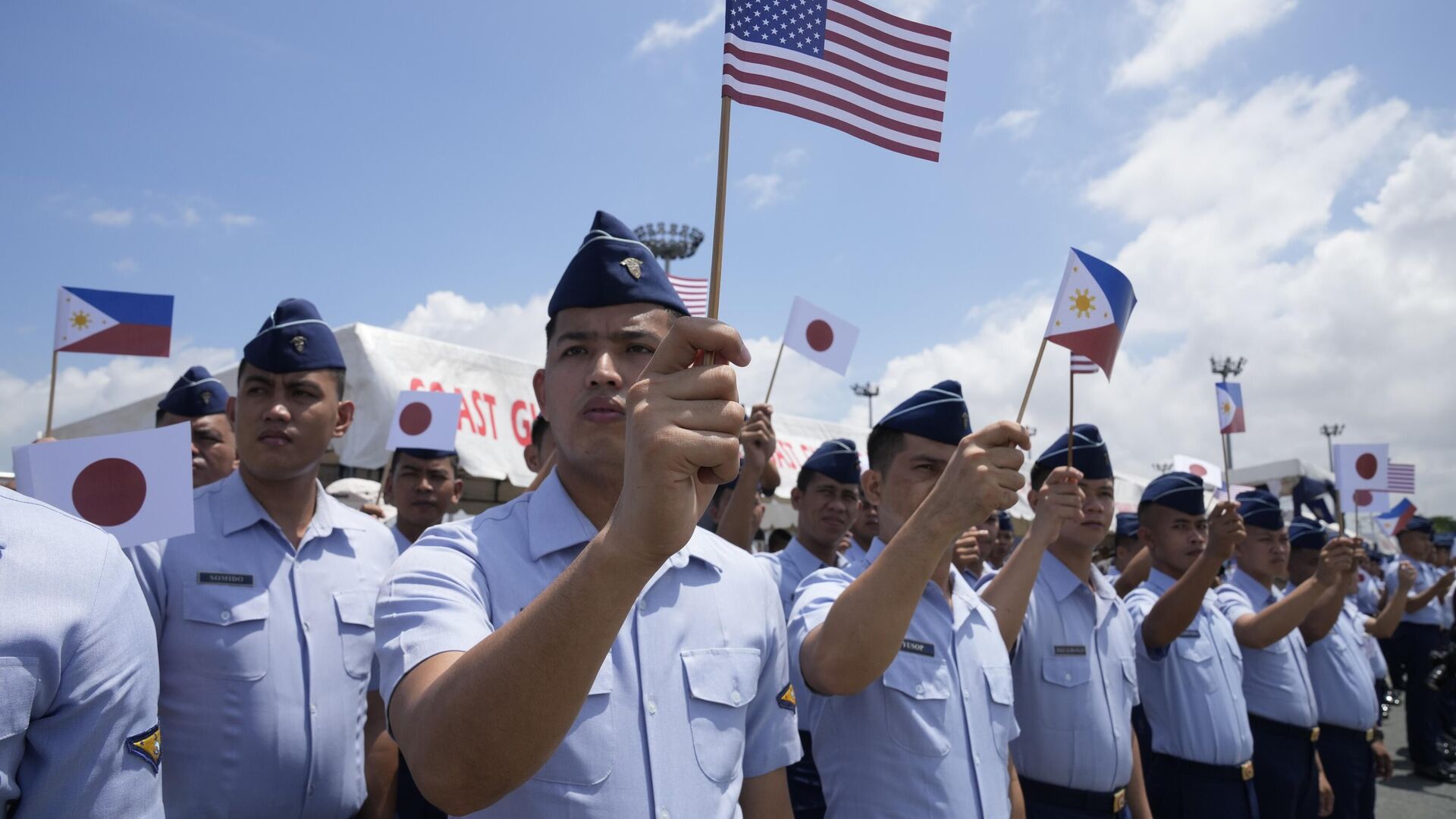https://sputnikglobe.com/20240427/us-encircling-china-with-military-bases-to-cut-off-ocean-access-in-conflict-scenario---reports-1118142625.html
US Encircling China With Military Bases to Cut Off Ocean Access in Conflict Scenario - Reports
US Encircling China With Military Bases to Cut Off Ocean Access in Conflict Scenario - Reports
Sputnik International
Washington's rhetoric about respecting the One-China principle that negates Taiwanese independence is frequently undermined by anti-China sentiments voiced by the US political establishment, multi-billion dollar aid packages for Taiwan and military efforts destabilizing security in the region.
2024-04-27T12:30+0000
2024-04-27T12:30+0000
2024-04-27T12:30+0000
military
joe biden
joseph wu
us
china
taiwan
philippines
pentagon
us navy
marine corps
https://cdn1.img.sputnikglobe.com/img/07e8/03/13/1117427026_0:188:3073:1916_1920x0_80_0_0_40d29ff27e03084556f8fefbd0ae7403.jpg
The US is building military bases near China to squeeze its naval capabilities out of the Pacific if a regional conflict were to break out, the New York Times (NYT) has reported, citing anonymous Chinese military strategists.The existing US-Philippines military agreements play a particular role in the plan. The Pentagon, having gained access to multiple airfields and naval bases in the Philippines, now has less need “for aircraft carriers that could be targeted by China’s long-range missiles and submarines in a time of war.”The US Navy has also deployed a new Marine Corps regiment on Okinawa, which is “designed to fight from small islands and destroy ships at sea."The Biden administration’s military initiative has faced criticism, with some arguing that the country should rather retain its major capabilities for domestic needs.Likewise, critics argue that transferring such major forces hinders the country’s manufacturing as the US “is not producing new ships and weapons systems quickly enough to deter China, which is rapidly growing its military.”Commenting on the US-China balance of forces, the incoming commander of the US Indo-Pacific Command noted that US lags behind China when it comes to military production.
https://sputnikglobe.com/20240422/southeast-asia-on-course-for-ukraine-style-crisis-amid-us-militarization-of-philippines-1118061126.html
https://sputnikglobe.com/20240422/expansive-us-philippines-war-games-slammed-by-china-as-tension-stoking--muscle-flexing-1118052253.html
china
taiwan
philippines
Sputnik International
feedback@sputniknews.com
+74956456601
MIA „Rossiya Segodnya“
2024
Sputnik International
feedback@sputniknews.com
+74956456601
MIA „Rossiya Segodnya“
News
en_EN
Sputnik International
feedback@sputniknews.com
+74956456601
MIA „Rossiya Segodnya“
Sputnik International
feedback@sputniknews.com
+74956456601
MIA „Rossiya Segodnya“
china us military standoff, china us military tensions, conflict in asia pacific, is us attacking china, tensions in south china sea, us philippines military ties
china us military standoff, china us military tensions, conflict in asia pacific, is us attacking china, tensions in south china sea, us philippines military ties
US Encircling China With Military Bases to Cut Off Ocean Access in Conflict Scenario - Reports
Washington's rhetoric about respecting the One-China principle that negates Taiwanese independence is frequently undermined by anti-China sentiments voiced by the US political establishment, multi-billion dollar aid packages for Taiwan and military efforts destabilizing security in the region.
The US is building
military bases near China to squeeze its naval capabilities out of the Pacific if a regional conflict were to break out, the New York Times (NYT) has reported, citing anonymous Chinese military strategists.
“The US efforts are aimed at keeping China’s naval forces behind the ‘first island chain’ — islands close to mainland Asia that run from Okinawa in Japan to Taiwan to the Philippines,” the reports read.
The existing
US-Philippines military agreements play a particular role in the plan. The Pentagon, having gained access to multiple airfields and naval bases in the Philippines, now has less need “
for aircraft carriers that could be targeted by China’s long-range missiles and submarines in a time of war.”
The report claims that Japan’s armed forces will receive some 400 Tomahawk cruise missiles, with its most advanced models able to attack ships and land targets over 1,150 miles (1,850 km) away.
The US Navy has also deployed a new Marine Corps regiment on Okinawa, which is “designed to fight from small islands and destroy ships at sea."
The Biden administration’s military initiative has faced criticism, with some arguing that the country should rather retain its major capabilities for domestic needs.
Likewise, critics argue that transferring such major forces hinders the country’s manufacturing as the US “is not producing new ships and weapons systems quickly enough to deter China, which is rapidly growing its military.”
Commenting on the
US-China balance of forces, the incoming commander of the US Indo-Pacific Command noted that US lags behind China when it comes to military production.
“But our trajectory is still not a trajectory that matches our adversary. Our adversaries are building more capability and they’re building more warships — per year — than we are,” Adm. Samuel J. Paparo Jr. told the NYT.
Tensions between the US and China soared in August 2022 after then-US House Speaker Nancy Pelosi traveled to Taiwan despite Beijing's warnings against the visit. Beijing condemned Pelosi's trip, which it regarded as a gesture of support for separatism, and launched large-scale military drills in the vicinity of the island.




